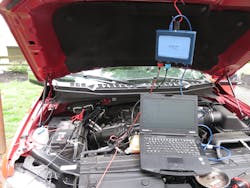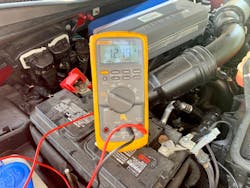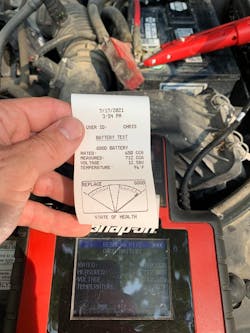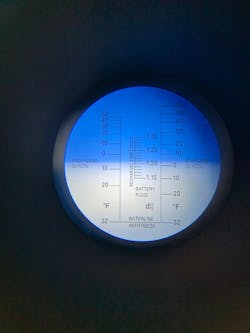Variations commonly found amongst 12V batteries on the market are absorbed glass-mat (AGM) and flooded lead-acid batteries (serviceable and non-serviceable). While diagnostics are similar, service and maintenance vary based on accessibility and chemical/structural variances amongst each type. Common testing procedures include the use of the following tools: digital multimeter; conductance tester (low amperage tool); refractometer (if battery is serviceable); load tester (high amperage tool); and/or PicoScope 4425A Digital Storage Oscilloscope (battery test option in PicoDiagnostics software).
Not all shops are willing to invest in such a broad array of tools for battery service and diagnostics, so it’s important to have a good understanding of all the options.
Digital multimeter (DMM) testing
While DMM’s do not provide a light-speed reaction to voltage variations based on sample rate, they do provide a stable enough reading to project static voltage, continuous declines in voltage, and charging system voltage output. One major issue to consider is where to make connection with the battery during such readings. In knowing that battery voltage is limited to connectivity between post and terminal, I recommend comparing post-to-post readings of battery voltage to post-to-terminal readings. Note that this process may be impacted by battery design, such as side post batteries.
While slight variances do exist amongst manufacturers to indicate a battery’s 100 percent state-of-charge, I typically project 12.6V is the norm (lead-acid). While cranking, a measurement of at or below 9.6V indicates severe battery degradation or poor maintenance, and further assessment must be conducted, such as charge and re-test following battery manufacturer’s recommendations, cell inspection (if serviceable), etc.
Conductance testing
Conductance testers utilize battery source voltage to measure current and infer resistive values in a complex, yet simple manner. This technology is similar to the use of DMM’s when performing basic testing procedures (voltage, resistance, and current measurements) to mathematically project measurable outcomes. The major benefits of utilizing conductance testers to determine battery conditions are the tool’s cost and size. Conductance testers are traditionally handheld, consume very little space, and are typically less expensive than dedicated carts used to assess battery condition. Conductance tester manufacturers currently equip their tools with exportable data files or immediate printable results to document battery condition at the time of measurement, and often include summaries of battery design, post arrangement (side/top/stud), voltage output, inferred amperage output, and battery condition based on tool analysis. This type of testing allows technicians to easily document their findings and display evidentiary results upon completing the test.
Load testing
One of the most stressful ways to assess a battery’s condition is by loading it to the point of higher amperage output readings upon testing. Load testers can be handheld or cart based. They may also be equipped with analog and/or digital readouts that assist a technician in documenting raw, measured values that project battery condition. In a carbon pile test, the battery is forced to conduct through carbon elements under pressure to measure live voltage and/or amperage. As pressure increases on the carbon pile, resistive value decreases and forces the battery to exhaust itself of stored electrons in an effort to project how stress impacts the battery’s performance. A major concern of using such a stressful load on a battery is damage to the battery and the potential for injury if the battery were to fail under such a heavy load.
Follow the load tester manufacturer’s instruction to limit the potential for damage or injury when operating.
Refractometer (specific gravity) testing
While many newer batteries are not serviceable, technicians in the industry will still encounter batteries that have removable service caps. This option allows technicians to sample individual cell acid and assess the density for diagnostic benefit. To begin the process, the refractometer must be calibrated with a few drops of distilled water being placed on the clean sample plate. Once the hinge plate (also called a “daylight plate”) is closed, the technician needs to point the sample plate towards a sufficient light source and view the measured value on the display. If the display indicates the sampled water has zero acidic value (32-degree freeze point), wipe the plate clean and begin sampling individual cells in a similar manner. If the distilled water does not show zero acidic value, the refractometer must be calibrated to zero to progress (typically done with a small, flathead screwdriver provided by the refractometer manufacturer).
Fortunately for us, most vehicle battery specific refractometers provide text indicating “good”, “fair”, or “needs recharged” based on calibrated values. Result of this type of test may vary with calibration or sampling errors.
PicoScope 4425A Digital Storage Oscilloscope
As the industry continues to use advanced methods of testing, my personal preference for assessing a battery’s condition is the Pico Diagnostics Battery Test. This test centralizes the most comprehensive data, projects dynamically physical values of voltage and current, and creates a file that can be saved, printed, shared, and displayed for reference and illustration.
This is an excerpt from the full article which can be found here.
About the Author
Chris Reynolds
Chris Reynolds is an ASE Master Technician, ASE-Education Foundation evaluation team leader, and an associate professor of automotive technology at Lewis & Clark Community College in Godfrey, Illinois. He is currently in his second year of study toward a Doctor of Education in Educational Practice degree at the University of Missouri – St. Louis. He enjoys time with his wife and three children and advocating for the needs of the automotive service industry and the field of technical education.
Sign up for our eNewsletters
Get the latest news and updates




